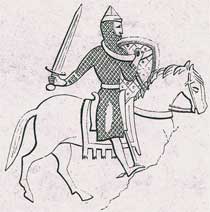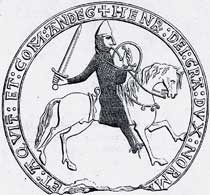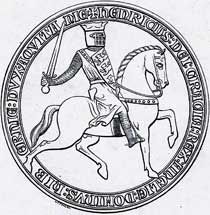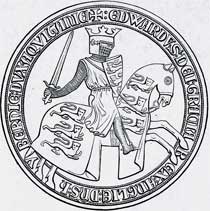Medieval Swords
The Medieval Swords were the knights' weapons par excellence. During the history of mankind, no other weapon carried so many symbols as the sword, and, in this context, the Medieval swords are a special case. The swords are indissolubly related to the most solemn ceremony of Chivalry, the Consecration of the Knight.
Medieval Swords PartsBefore proceeding to a chronological description, let's have a quick look at the sword construction.
The two essential parts of the Medieval swords are the blade and the hilt.
The prolongation of the blade which fits into the handle is the tang; the upper portion near the hilt
is the ricasso.
The essential portions of the hilt are the quillons, which cross at right angles between the blade and the handle to protect the hand;
the grip, which is self-explanatory, and the pommel, the expanded piece at the end of the grip.

Norman Period Sword
Medieval Swords History

Seal of King Henry II
During the Pre-Norman Period, the swords in use throughout Europe were of the Scandinavian type, and may be divided into three classes:
(1) those having the character of a broadsword, with parallel sharp edges and an acute point, and the tang only for a grip;
(2) a similar variety having a cross guard; and (3) a sword with the blade slightly curved.
From the Norman Conquest till the end of the 12th Century, the grip of the swords was usually of wood, covered with skin, but sometimes of bone. The cross-guards began in a simple projection, but increased as time went on; together with the pommel,
they were at times highly ornamented, inlaid with precious stones. The sheaths were usually of leather, stiffened with a wood framing.
The blade of the swords of this period was always two-edged, and about forty inches in length; the quillons were generally straight, in other cases curved towards the blade, as in the Great Seal of King Henry II; the grip varied perhaps more than any other part, being at times
almost double handed. The shape of the pommel takes many forms: round, hemispherical, square, lozenge, trefoiled or cinquefoiled.
The swords of the 13th Century resembled those of the preceding epoch. The blade was straight, broad, double-edged, and pointed. The type is well shown in the Second Seal of King Henry III. The cross-piece was usually curved towards the blade. Sometimes the curved guard threw out a kind of cusp in the middle. The crossbar was at other times straight. A variety of the straight guard forms also a cusp over the centre of the blade.
The pommel of the Medieval swords takes many forms: the round, the trefoil, the cinquefoil, the rosette, the lozenge, the conical, the pear-shaped, the square, and the fleur-de-lis, as in the Seal of King Edward I. The round pommel is either plain or ornamented on its sides: in the latter case the ornament is usually a cross, or a shield of arms. The plain round pommel is generally wheel-formed; that is, it has a projection in the centre something like the nave of a wheel. The sacred symbol of the Cross is very frequently found on the circular pommel.

Second Seal of King Henry III
The handle of the Medieval Swords is sometimes of a highly enriched character. That of King John, on his monument in Worcester Cathedral, represents a sword in which both the pommel and cross-bar were inlaid with precious stones. The sheath also occasionally exhibits enrichments. These are either metal harnessing of Gothic patterns, similar to the architectural designs of the day, or the scabbard is embellished from end to end with a series of shields of arms.

Great Seal of King Edward I
In the 14th Century, the swords were straight, broad, and acutely pointed, with a simple cross-piece for guard, thus retaining the characteristics of the previous century. The length of the blade was not uniform, there were blades of 2 feet and 8 inches, but also of 2 feet and 1 inch. The cross-piece was usually either straight, or curved towards the blade. More rarely it curves in the opposite direction, or has an angular form. The first kind has varieties in which the centre is cusped, or the extremities are molded into foils or volutes. The pommel offers great diversity of form. It is round, wheel-formed, trefoil, lozenge-shaped, angular, conical, pear-shaped. The pommel is sometimes charged with a cross, or contains an escutcheon of arms. The blades were often covered with Latin inscriptions.
In the 15th Century, the swords maintained the same characteristics. The pear-shaped pommel may be considered as defining the type for this century.
Of a distinct category are the swords used mostly by the more humble soldiers.
15th Century Sword
Medieval Swords used by lower ranks and civilians
The Falchion was chiefly used by archers and men-at-arms. It had a blade wide at the point; the edge was curved and convex, the back concave. The Cultellus was a short sword, and is not often mentioned or represented. It was designed especially for the use of foot soldiers when rushing upon knights who had been dismounted in a cavalry charge, or for the close encounter of infantry against infantry.
Among the Medieval swords, the Anelace was very popular with the civilians. It was a long dagger which was secured to the person by a chain.
It is often represented upon effigies and brasses of civilians in the 14th and 15th centuries, and at times assumed very large proportions. The handle was made in the fashion
of that of the cinquedea, from which it was probably derived. The latter is a dagger or short sword which had its origin in Italy; the blade is generally of the width of
five fingers at the hilt (whence the name); the quillons always bend towards the blade;
it was two-edged, and averaged from eighteen to twenty inches in length.
The Medieval swords remained to this day the symbols of honor, courage, faith, and religion, which were the pillars of Knighthood itself.
